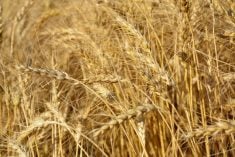Glacier FarmMedia – Wheat has taken its turn as a food ‘villain.’
For instance, in the early 2010s, the book Wheat Belly by cardiologist Dr. William Davis told consumers that wheat, and in fact most grains, was a cause of the flab around their belly, joint pain, eczema, and even depression and anxiety.
The book was a bestseller, and spawned a ‘Wheat Belly Diet’ and other spinoffs.
Read Also

Canada seventh-most influential country on agri-food
Report from Dalhousie University and MNP shows Canada ranks seventh among G20 countries on agri-food influence.
In 2012, as the book was in its heyday, Kim Kardashian said she’d cut wheat from her diet, a CBC article from October of that year says. Gluten-free was touted as a healthier diet for everyone, not just those with celiac disease or diagnosed gluten intolerances.
Why it matters: A new website from Cereals Canada on wheat will provide information on the crop and its nutritional benefits for dieticians and consumers.
The market for gluten-free products continues to grow — projected to hit a $7.5-billion value by 2027, according to a 2020 report from Allied Market Research.
By and large, however, consumers today don’t think wheat is bad, said Ellen Pruden, director of communications for Cereals Canada.
They’d like to keep it that way.
On Feb. 17, Cereals Canada, through its Canadian Wheat Nutrition Initiative, launched the website WhatAboutWheat.ca. It’s a catch-all resource on wheat for dietitians and ordinary ‘eaters.’
“Our goal is to make it simple for nutrition professionals to find and share wheat nutrition information with clients, and for consumers to learn more about wheat,” said Elaine Sopiwnyk, Cereals Canada’s vice-president of technical services in a Feb. 17 news release.
The site contains a ‘Wheat 101,’ which walks through the basics of what wheat is, how it’s grown (taking care to specify that no genetically modified wheat varieties grow in Canada), and what products come from wheat.
For instance, it defines the difference between 100 per cent whole grain, whole wheat flour and ordinary whole wheat flour. (Regular whole wheat is missing five per cent of the grain kernel including most of the germ and some of the bran. This increases shelf life.)
‘Canada’s wheat story’ elaborates on farming practices, and where wheat goes once it leaves the farm.
Finally, the site contains nutrition research from peer-reviewed research data.
The website will also serve as a resource for wheat crop organizations and producer groups across Canada, which until now have lacked a unified resource, said Pruden.
Cereals Canada will conduct seminars for dietitians to familiarize them with the wheat resource.
It will also collaborate with IlCereales, the Latin America Cereals Institute, to reach dietitians in Latin American countries that buy Canadian wheat.
– This article was originally published at the Manitoba Co-operator.















